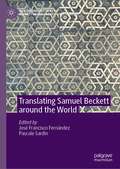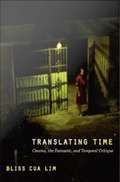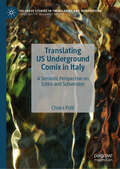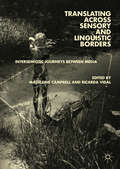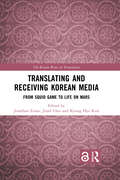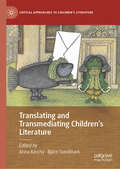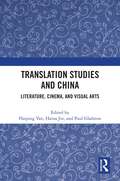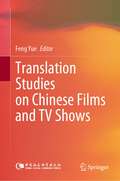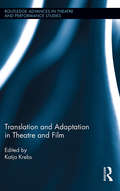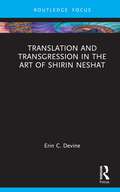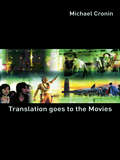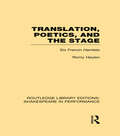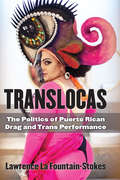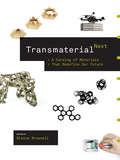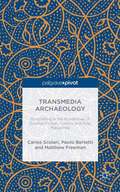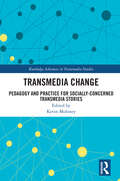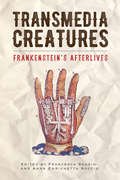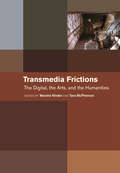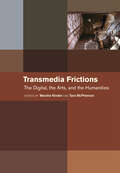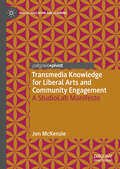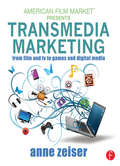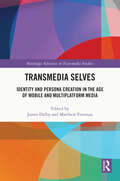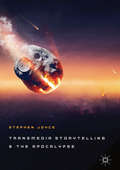- Table View
- List View
Translating Samuel Beckett around the World (New Interpretations of Beckett in the Twenty-First Century)
by José Francisco Fernández Pascale SardinThe global reception of Samuel Beckett raises numerous questions: in which areas of the world was Beckett first translated? Why were Beckett texts sometimes slow to penetrate certain cultures? How were national literatures impacted by Beckett's oeuvre? Translating Samuel Beckett around the World brings together leading researchers in Beckett studies to discuss these questions and explore the fate of Beckett in their own societies and national languages. The current text provides ample coverage of the presence of Beckett in geographical contexts normally ignored by literary criticism, and reveals unknown aspects of the 1969 Nobel Prize winner interacting with translators of his work in a number of different countries.
Translating Time: Cinema, the Fantastic, and Temporal Critique
by Bliss Cua LimUnder modernity, time is regarded as linear and measurable by clocks and calendars. Despite the historicity of clock-time itself, the modern concept of time is considered universal and culturally neutral. What Walter Benjamin called "homogeneous, empty time" founds the modern notions of progress and a uniform global present in which the past and other forms of time consciousness are seen as superseded. In Translating Time, Bliss Cua Lim argues that fantastic cinema depicts the coexistence of other modes of being alongside and within the modern present, disclosing multiple "immiscible temporalities" that strain against the modern concept of homogeneous time. In this wide-ranging study--encompassing Asian American video (On Cannibalism), ghost films from the New Cinema movements of Hong Kong and the Philippines (Rouge, Itim, Haplos), Hollywood remakes of Asian horror films (Ju-on, The Grudge, A Tale of Two Sisters) and a Filipino horror film cycle on monstrous viscera suckers (Aswang)--Lim conceptualizes the fantastic as a form of temporal translation. The fantastic translates supernatural agency in secular terms while also exposing an untranslatable remainder, thereby undermining the fantasy of a singular national time and emphasizing shifting temporalities of transnational reception. Lim interweaves scholarship on visuality with postcolonial historiography. She draws on Henri Bergson's understanding of cinema as both implicated in homogeneous time and central to its critique, as well as on postcolonial thought linking the ideology of progress to imperialist expansion. At stake in this project are more ethical forms of understanding time that refuse to domesticate difference as anachronism. While supernaturalism is often disparaged as a vestige of primitive or superstitious thought, Lim suggests an alternative interpretation of the fantastic as a mode of resistance to the ascendancy of homogeneous time and a starting-point for more ethical temporal imaginings.
Translating US Underground Comix in Italy: A Semiotic Perspective on Satire and Subversion (Palgrave Studies in Translating and Interpreting)
by Chiara PolliThis book analyses 1960s-1970s US underground comix, a &‘counterculture&’ art form that satirised mainstream values and taboos. The author observes comix in their multimodal components in the original English-language versions and in their Italian translations by unpacking the several layers of verbal and visual meaning-making. She then goes on to scrutinise translation and resemiotisation processes, including modifications, mitigations, and omissions, encompassing socio-historical and cross-cultural perspectives. The book argues that translation, meant to bridge two (counter-)cultures, served as a gatekeeper instead, zooming in on certain themes, while inadvertently overlooking or purposefully manipulating others, with an outcome close to censorship. The volume is divided into nine chapters. Chapter 1 summarises the aims and scope of the volume. Chapter 2 introduces comix as a subversive phenomenon. Chapter 3 illustrates the theoretical and methodological framework of analysis, based on semiotics and multimodality. Chapter 4 presents the corpus of Italian translations, which includes works translated between 1968 and 2022 by both mainstream and alternative publishers. In Chapters 5-8, Italian translations of comix dealing with such controversial themes as sex, drugs, political struggle, and religion are analysed, with qualitative observations of several translations of the same comix provided to highlight changing times, cultural frames, ideologies, editorial policies, and target audiences. Chapter 9 discusses the findings of these observations and maintains that, as a recursive translation strategy, seditious contents were mitigated, trivialised, or censored by adopting light-hearted frames so that potentially problematic contents could be left out. With its linguistic, translational, and intercultural analyses, this volume will be useful for researchers of linguistics, semiotics, translation, and comics studies.
Translating across Sensory and Linguistic Borders: Intersemiotic Journeys between Media
by Ricarda Vidal Madeleine CampbellThis book analyses intersemiotic translation, where the translator works across sign systems and cultural boundaries. Challenging Roman Jakobson’s seminal definitions, it examines how a poem may be expressed as dance, a short story as an olfactory experience, or a film as a painting. This emergent process opens up a myriad of synaesthetic possibilities for both translator and target audience to experience form and sense beyond the limitations of words. The editors draw together theoretical and creative contributions from translators, artists, performers, academics and curators who have explored intersemiotic translation in their practice. The contributions offer a practitioner’s perspective on this rapidly evolving, interdisciplinary field which spans semiotics, cognitive poetics, psychoanalysis and transformative learning theory. The book underlines the intermedial and multimodal nature of perception and expression, where semiotic boundaries are considered fluid and heuristic rather than ontological. It will be of particular interest to practitioners, scholars and students of modern foreign languages, linguistics, literary and cultural studies, interdisciplinary humanities, visual arts, theatre and the performing arts.
Translating and Receiving Korean Media: From Squid Game to Life on Mars (The Korean Wave in Translation)
by Jonathan Evans Kyung Hye Kim Jinsil ChoiIn recent years, Korean culture has been incredibly successful internationally, from the films of auteur directors like Bong Joon-ho (Parasite) to shows like Squid Game and K-pop music. At the same time, media from the UK has also been successful in South Korea, with popular shows such as Killing Eve and Life on Mars. Written by scholars working across translation, film and media studies, this volume examines the ways in which Korean media has been received and translated in the UK, as well as how British media has fared in South Korea. Case studies explore how Korean media is (re)packaged and categorised for a Western audience and how paratextual material (trailers, adverts, fan reactions) mediates films and shows for international audiences. The book also examines how the Korean remake of Life on Mars localises the British show, how Squid Game has been audio-described and how slower media models can suggest more sustainable forms of consumption and distribution. Demonstrating how interdisciplinary research can shed light on different aspects of global media culture, this volume will be essential reading for scholars and students working on the translation and international media circulation. It will especially appeal to readers interested in the interactions between British and Korean media.This work was supported by the Fund for International Collaboration and the Economic and Social Research Council [grant number ES/W01081X/1].
Translating and Transmediating Children’s Literature (Critical Approaches to Children's Literature)
by Björn Sundmark Anna KérchyFrom Struwwelpeter to Peter Rabbit, from Alice to Bilbo—this collection of essays shows how the classics of children’s literature have been transformed across languages, genres, and diverse media forms. This book argues that translation regularly involves transmediation—the telling of a story across media and vice versa—and that transmediation is a specific form of translation. Beyond the classic examples, the book also takes the reader on a worldwide tour, and examines, among other things, the role of Soviet science fiction in North Korea, the ethical uses of Lego Star Wars in a Brazilian context, and the history of Latin translation in children’s literature. Bringing together scholars from more than a dozen countries and language backgrounds, these cross-disciplinary essays focus on regularly overlooked transmediation practices and terminology, such as book cover art, trans-sensory storytelling, écart, enfreakment, foreignizing domestication, and intra-cultural transformation.
Translation Studies and China: Literature, Cinema, and Visual Arts
by Haiping YanFocusing on transculturality, this edited volume explores how the role of translation and the idea of (un)translatability in the transformative complementation of different civilizations facilitates the transcultural connection between Chinese and other cultures in the modern era. Bringing together established international scholars and emerging new voices, this collection explores the linguistic, social, and cultural implications of translation and transculturality. The 13 chapters not only discuss the translation of literature, but also break new ground by addressing the translation of cinema, performance, and the visual arts, which are active bearers of modern and contemporary culture that are often neglected by academics. Through an engagement with these diverse fields, the title aims not only to reflect on how translation has reproduced values, concepts, and cultural forms, but also to stimulate the emergence of new possibilities in the dynamic transcultural interplay between China and the diverse national, cultural-linguistic, and contexts of Europe, the Americas, and Asia. It shows how cultures have been appropriated, misunderstood, transformed, and reconstructed through processes of linguistic mediation, as well as how knowledge, understanding, and connections have been generated through transculturality. The book will be a must read for scholars and students of translation studies, transcultural studies, and Chinese studies.
Translation Studies on Chinese Films and TV Shows
by Feng YueThis book explores translation strategies for films and TV programs. On the basis of case studies on subtitle translations, it argues that translators are expected to take into consideration not only linguistic and cultural differences but also the limits of time and space. Based on the editor’s experience working as a translator for TV, journalist, and narrator, this book proposes employing editorial translation for TV translation. Further, in light of statistics on international audiences’ views on Chinese films, it suggests striking a balance between conveying cultural messages and providing good entertainment.
Translation and Adaptation in Theatre and Film (Routledge Advances in Theatre & Performance Studies)
by Katja KrebsThis book provides a pioneering and provocative exploration of the rich synergies between adaptation studies and translation studies and is the first genuine attempt to discuss the rather loose usage of the concepts of translation and adaptation in terms of theatre and film. At the heart of this collection is the proposition that translation studies and adaptation studies have much to offer each other in practical and theoretical terms and can no longer exist independently from one another. As a result, it generates productive ideas within the contact zone between these two fields of study, both through new theoretical paradigms and detailed case studies. Such closely intertwined areas as translation and adaptation need to encounter each other’s methodologies and perspectives in order to develop ever more rigorous approaches to the study of adaptation and translation phenomena, challenging current assumptions and prejudices in terms of both. The book includes contributions as diverse yet interrelated as Bakhtin’s notion of translation and adaptation, Bollywood adaptations of Shakespeare’s Othello, and an analysis of performance practice, itself arguably an adaptive practice, which uses a variety of languages from English and Greek to British and International Sign-Language. As translation and adaptation practices are an integral part of global cultural and political activities and agendas, it is ever more important to study such occurrences of rewriting and reshaping. By exploring and investigating interdisciplinary and cross-cultural perspectives and approaches, this volume investigates the impact such occurrences of rewriting have on the constructions and experiences of cultures while at the same time developing a rigorous methodological framework which will form the basis of future scholarship on performance and film, translation and adaptation.
Translation and Transgression in the Art of Shirin Neshat (Routledge Focus on Art History and Visual Studies)
by Erin C. DevinePrecisely 30 years after the debut of her provocative photo-portraits, this book chronicles the early career of Iranian-American artist Shirin Neshat. In its first 20 years, Neshat’s work weaved viewers into complex readings of women and power in Iran. Yet her images also drew criticisms of exoticizing Muslim women, and later video installations were accused of lacking political assertion during stormy relations between the West and the Islamic world. Now broadly recognized as a social justice artist, this volume chronicles Neshat’s evolution from photography to film, from personal to political expression, and expands existing scholarship to investigate underserved contexts for her work, including the cinematic turn and emergent theories of globality in contemporary art. Neshat’s hyphenated identity was often attenuated by reductive and exoticizing discourses; therefore, this volume draws attention to her transnational methodologies, informed by strategies of appropriation, performativity, and embodiment while articulating Persian visual and literary traditions. Complicating simplistic ethnographies, her disruption of neo-Orientalist paradigms and representations has led audiences to reconsider Islamophobic, Islamism, and gender repressions that are political, psychological, and above all cross-cultural. This book will be of interest to scholars working in art history, photography, cinema studies, performance, transnational and global studies, women’s studies, and Iranian studies.
Translation goes to the Movies
by Michael CroninThis highly accessible introduction to translation theory, written by a leading author in the field, uses the genre of film to bring the main themes in translation to life. Through analyzing films as diverse as the Marx Brothers’ A Night at the Opera, The Star Wars Trilogies and Lost in Translation, the reader is encouraged to think about both issues and problems of translation as they are played out on the screen and issues of filmic representation through examining the translation dimension of specific films. In highlighting how translation has featured in both mainstream commercial and arthouse films over the years, Cronin shows how translation has been a concern of filmmakers dealing with questions of culture, identity, conflict and representation. This book is a lively and accessible text for translation theory courses and offers a new and largely unexplored approach to topics of identity and representation on screen. Translation Goes to the Movies will be of interest to those on translation studies and film studies courses.
Translation, Poetics, and the Stage: Six French Hamlets (Routledge Library Editions: Shakespeare in Performance)
by Romy HeylenThis book establishes an analytical model for the description of existing translations in their historical context within a framework suggested by systemic concepts of literature. It argues against mainstream 20th-century translation theory and, by proposing a socio-cultural model of translation, takes into account how a translation functions in the receiving culture. The case studies of successive translations of "Hamlet" in France from the eighteenth century neoclassical version of Jean-Francois Ducis to the 20th-century Lacanian, post-structuralist stage production of Daniel Mesguich show the translator at work. Each chapter focuses on a different aspect of the changing theatrical and literary norms to which translators through the ages have been bound by the expectations both of their audiences and the literary establishment.
Translocal Performance in Asian Theatre and Film
by Iris H. TuanThis pivot offers an innovative, trans-local perspective on performance studies in the era of digital technology, considering a range of content from theater to opera, film, dance, and musical theatre. It examines theatre performing arts and film in terms of aesthetics, gender studies, and identity politics, and showcases the value of human accomplishments in theatre and film and their representative artistic works. It also addresses key issues within performance studies, such as gender, class, race, ethnicity, identity, and how minorities portray their ethnicity stories. This book links the trans-national and the trans-local and considers how emerging mobile geographies and new methodologies of interpreting performance in theatre and film reflect the transformations of our understanding of geopolitical time and space.
Translocas: The Politics of Puerto Rican Drag and Trans Performance (Triangulations: Lesbian/Gay/Queer Theater/Drama/Performance)
by Lawrence La Fountain-StokesTranslocas focuses on drag and transgender performance and activism in Puerto Rico and its diaspora. Arguing for its political potential, Lawrence La Fountain-Stokes explores the social and cultural disruptions caused by Latin American and Latinx “locas” (effeminate men, drag queens, transgender performers, and unruly women) and the various forms of violence to which queer individuals in Puerto Rico and the U.S. are subjected. This interdisciplinary, auto-ethnographic, queer-of-color performance studies book explores the lives and work of contemporary performers and activists including Sylvia Rivera, Nina Flowers, Freddie Mercado, Javier Cardona, Jorge Merced, Erika Lopez, Holly Woodlawn, Monica Beverly Hillz, Lady Catiria, and Barbra Herr; television programs such as RuPaul’s Drag Race; films such as Paris Is Burning, The Salt Mines, and Mala Mala; and literary works by authors such as Mayra Santos-Febres and Manuel Ramos Otero. Lawrence La Fountain-Stokes, a drag performer himself, demonstrates how each destabilizes (and sometimes reifies) dominant notions of gender and sexuality through drag and their embodied transgender expression. These performances provide a means to explore and critique issues of race, class, poverty, national identity, and migratory displacement while they posit a relationship between audiences and performers that has a ritual-like, communal dimension. The book also analyzes the murders of Jorge Steven López Mercado and Kevin Fret in Puerto Rico, and invites readers to challenge, question, and expand their knowledge about queer life, drag, trans performance, and Puerto Rican identity in the Caribbean and the diaspora. The author also pays careful attention to transgender experience, highlighting how trans activists and performers mold their bodies, promote social change, and create community in a context that oscillates between glamour and abjection.
Translucent Building Skins: Material Innovations in Modern and Contemporary Architecture
by Scott MurrayExploring the design of innovative building enclosure systems (or skins) in contemporary architecture and their precedents in earlier twentieth century modern architecture, this book examines the tectonics, the history and the influence of translucency as a defining characteristic in architecture. Highly illustrated throughout with drawings and full colour photographs, the book shows that translucency has been and continues to be a fertile ground for architectural experimentation. Each chapter presents a comparative analysis of two primary buildings: a recent project, paired with a historical precedent, highlighting how architects in different eras have realized the distinctive effects of translucency. The included buildings span a variety of program types, ranging from a single-family residence, to a factory, to a synagogue. Whether it is Pierre Chareau’s glass-lens curtain wall at the Maison de Verre, Frank Lloyd Wright’s wall of stacked glass tubes at the Johnson Wax Research Tower, or Peter Zumthor’s use of acid-etched glass in a double-skin envelope at the Kunsthaus Bregenz, the included projects each offer an exemplary case study of innovations in materiality and fabrication techniques. Today, among many contemporary architects, there is an engagement with new technologies, new material assemblies, and new priorities such as sustainability and energy-efficiency. A resurgent interest in translucency as a defining quality in buildings has been an important part of this recent dialogue and this book makes essential reading for any architect looking to incorporate aspects of translucency into their buildings.
Transmaterial Next: A Catalog of Materials that Redefine Our Future
by Blaine BrownellVirtually every revolution in architecture has been preceded by a revolution in materials: think iron, glass, steel, concrete, plastics, or composites. What is the next revolutionary material that will reshape the very nature of architecture? A solid that's lighter than air, metal latticework so delicate it rests on a dandelion, building insulation made from processed seaweed, self-generating microbial glue that repairs cracks in concrete, or transparent solar panels? Materials expert Blaine Brownell, author of our bestselling Transmaterial series, reveals emerging trends and applications that are transforming the technological capacity, environmental performance, and design potential of architecture in Transmaterial Next. This book is an essential compendium for thinking architects, designers, and other creative professionals passionate about materials and looking for their bleeding edge and practical implementation.
Transmedia Archaeology: Storytelling in the Borderlines of Science Fiction, Comics and Pulp Magazines
by Matthew Freeman Carlos A. Scolari Paolo BertettiIn this book, the authors examine manifestations of transmedia storytelling in different historical periods and countries, spanning the UK, the US and Argentina. It takes us into the worlds of Conan the Barbarian, Superman and El Eternauta, introduces us to the archaeology of transmedia, and reinstates the fact that it's not a new phenomenon.
Transmedia Change: Pedagogy and Practice for Socially-Concerned Transmedia Stories (Routledge Advances in Transmedia Studies)
by Kevin MoloneyThis book examines and illustrates the use of design principles, design thinking, and other empathy research techniques in university and public settings, to plan and ethically target socially-concerned transmedia stories and evaluate their success through user experience testing methods. All media industries continue to adjust to a dispersed, diverse, and dilettante mediascape where reaching a large global audience may be easy but communicating with a decisive and engaged public is more difficult. This challenge is arguably toughest for communicators who work to engage a public with reality rather than escape. The chapters in this volume outline the pedagogy and practice of design, empathy research methods for story development, transmedia logics for socially-concerned stories, development of community engagement and the embrace of collective narrative, art and science research collaboration, the role of mixed and virtual reality in prosocial communication, ethical audience targeting, and user experience testing for storytelling campaigns. Each broad topic includes case examples and full case studies of each stage in production. Offering a detailed exploration of a fast-emerging area, this book will be of great relevance to researchers and university teachers of socially-concerned transmedia storytelling in fields such as journalism, documentary filmmaking, education, and activism.
Transmedia Creatures: Frankenstein’s Afterlives
by Claire Nally Diego Saglia Ruth Heholt Andrew McInnes Lidia De Michelis Eleanor Beal Gino Roncaglia Claudia Gualtieri Federico Meschini Enrico Reggiani Daniele Pio Buenza Janet LarsonOn the 200th anniversary of the first edition of Mary Shelley’s Frankenstein, Transmedia Creatures presents studies of Frankenstein by international scholars from converging disciplines such as humanities, musicology, film studies, television studies, English and digital humanities. These innovative contributions investigate the afterlives of a novel taught in a disparate array of courses - Frankenstein disturbs and transcends boundaries, be they political, ethical, theological, aesthetic, and not least of media, ensuring its vibrant presence in contemporary popular culture. Transmedia Creatures highlights how cultural content is redistributed through multiple media, forms and modes of production (including user-generated ones from “below”) that often appear synchronously and dismantle and renew established readings of the text, while at the same time incorporating and revitalizing aspects that have always been central to it. The authors engage with concepts, value systems and aesthetic-moral categories—among them the family, horror, monstrosity, diversity, education, risk, technology, the body—from a variety of contemporary approaches and highly original perspectives, which yields new connections. Ultimately, Frankenstein, as evidenced by this collection, is paradoxically enriched by the heteroglossia of preconceptions, misreadings, and overreadings that attend it, and that reveal the complex interweaving of perceptions and responses it generates. Published by Bucknell University Press. Distributed worldwide by Rutgers University Press.
Transmedia Frictions
by Tara Mcpherson Marsha KinderEditors Marsha Kinder and Tara McPherson present an authoritative collection of essays on the continuing debates over medium specificity and the politics of the digital arts. Comparing the term "transmedia" with "transnational," they show that the movement beyond specific media or nations does not invalidate those entities but makes us look more closely at the cultural specificity of each combination. In two parts, the book stages debates across essays, creating dialogues that give different narrative accounts of what is historically and ideologically at stake in medium specificity and digital politics. Each part includes a substantive introduction by one of the editors. Part 1 examines precursors, contemporary theorists, and artists who are protagonists in this discursive drama, focusing on how the transmedia frictions and continuities between old and new forms can be read most productively: N. Katherine Hayles and Lev Manovich redefine medium specificity, Edward Branigan and Yuri Tsivian explore nondigital precursors, Steve Anderson and Stephen Mamber assess contemporary archival histories, and Grahame Weinbren and Caroline Bassett defend the open-ended mobility of newly emergent media. In part 2, trios of essays address various ideologies of the digital: John Hess and Patricia R. Zimmerman, Herman Gray, and David Wade Crane redraw contours of race, space, and the margins; Eric Gordon, Cristina Venegas, and John T. Caldwell unearth database cities, portable homelands, and virtual fieldwork; and Mark B.N. Hansen, Holly Willis, and Rafael Lozano-Hemmer and Guillermo Gómez-Peña examine interactive bodies transformed by shock, gender, and color. An invaluable reference work in the field of visual media studies, Transmedia Frictions provides sound historical perspective on the social and political aspects of the interactive digital arts, demonstrating that they are never neutral or innocent.
Transmedia Frictions: The Digital, the Arts, and the Humanities
by Marsha Kinder and Tara McPhersonEditors Marsha Kinder and Tara McPherson present an authoritative collection of essays on the continuing debates over medium specificity and the politics of the digital arts. Comparing the term "transmedia" with "transnational," they show that the movement beyond specific media or nations does not invalidate those entities but makes us look more closely at the cultural specificity of each combination. In two parts, the book stages debates across essays, creating dialogues that give different narrative accounts of what is historically and ideologically at stake in medium specificity and digital politics. Each part includes a substantive introduction by one of the editors. Part 1 examines precursors, contemporary theorists, and artists who are protagonists in this discursive drama, focusing on how the transmedia frictions and continuities between old and new forms can be read most productively: N. Katherine Hayles and Lev Manovich redefine medium specificity, Edward Branigan and Yuri Tsivian explore nondigital precursors, Steve Anderson and Stephen Mamber assess contemporary archival histories, and Grahame Weinbren and Caroline Bassett defend the open-ended mobility of newly emergent media. In part 2, trios of essays address various ideologies of the digital: John Hess and Patricia R. Zimmerman, Herman Gray, and David Wade Crane redraw contours of race, space, and the margins; Eric Gordon, Cristina Venegas, and John T. Caldwell unearth database cities, portable homelands, and virtual fieldwork; and Mark B.N. Hansen, Holly Willis, and Rafael Lozano-Hemmer and Guillermo Gómez-Peña examine interactive bodies transformed by shock, gender, and color. An invaluable reference work in the field of visual media studies, Transmedia Frictions provides sound historical perspective on the social and political aspects of the interactive digital arts, demonstrating that they are never neutral or innocent.
Transmedia Knowledge for Liberal Arts and Community Engagement: A StudioLab Manifesto (Digital Education and Learning)
by Jon McKenzieThis book sets forth a pedagogy for renewing the liberal arts by combining critical thinking, media activism, and design thinking. Using the StudioLab approach, the author seeks to democratize the social and technical practices of digital culture just as nineteenth century education sought to democratize literacy. This production of transmedia knowledge—from texts and videos to comics and installations—moves students between seminar, studio, lab, and field activities. The book also wrestles with the figure of Plato and the very medium of knowledge to re-envision higher education in contemporary societies, issuing a call for community engagement as a form of collective thought-action.
Transmedia Marketing: From Film and TV to Games and Digital Media (American Film Market Presents)
by Anne ZeiserTransmedia Marketing: From Film and TV to Games and Digital Media skillfully guides media makers and media marketers through the rapidly changing world of entertainment and media marketing. Its groundbreaking transmedia approach integrates storytelling and marketing content creation across multiple media platforms – harnessing the power of audience to shape and promote your story. Through success stories, full color examples of effective marketing techniques in action, and insight from top entertainment professionals, Transmedia Marketing covers the fundamentals of a sound 21st century marketing and content plan. You’ll master the strategy behind conducting research, identifying target audiences, setting goals, and branding your project. And, you’ll learn first-hand how to execute your plan’s publicity, events, advertising, trailers, digital and interactive content, and social media. Transmedia Marketing enlivens these concepts with: Hundreds of vibrant examples from across media platforms – The Hunger Games, Prometheus, The Dark Knight, Bachelorette, The Lord of the Rings, Despicable Me 2, Food, Inc., Breaking Bad, House of Cards, Downton Abbey, Game of Thrones, Top Chef, Pokémon, BioShock Infinite, Minecraft, Outlast, Titanfall, LEGO Marvel Super Heroes, Halo 4, Lonelygirl15, Annoying Orange Real-world advice from 45 leading industry writers, directors, producers, composers, distributors, marketers, publicists, critics, journalists, attorneys, and executives from markets, festivals, awards, and guilds Powerful in-depth case studies showcasing successful approaches – A.I. Artificial Intelligence, Mad Men, Lizzie Bennet Diaries, Here Comes Honey Boo Boo, and Martin Scorsese Presents the Blues Extensive Web content at www.transmediamarketing.com featuring a primer on transmedia platforms – film, broadcast, print, games, digital media, and experiential media; expanded case studies; sample marketing plans and materials; and exclusive interviews With Transmedia Marketing, you’ll be fully versed in the art of marketing film, TV, games, and digital media and primed to write and achieve the winning plan for your next media project.
Transmedia Selves: Identity and Persona Creation in the Age of Mobile and Multiplatform Media (Routledge Advances in Transmedia Studies)
by Matthew Freeman James DalbyThis book examines the mediated shift in the contemporary human condition, focusing on the ways in which we synthesise with media content in daily life, essentially transmediating ourselves into new forms and (re)creating ourselves across media. Across an international roster of essays, this book establishes a transdisciplinary theory for the ‘transmedia self’, exploring how technological ubiquity and digital self-determination combine with themes and disciplines such as celebrity culture, fandom, play, politics, and ultimately broader self-conception and projection to inform the creation of transmedia identities in the twenty-first century. Specifically, the book repositions transmediality as key to understanding the formation of identity in a post-digital media culture and transmedia age, where our lives are interlaced, intermingled, and narrativised across a range of media platforms and interfaces. This book is ideal for scholars and students interested in transmedia storytelling, cultural studies, media studies, sociology, philosophy, and politics.
Transmedia Storytelling and the Apocalypse
by Stephen JoyceThis book confronts the question of why our culture is so fascinated by the apocalypse. It ultimately argues that while many see the post-apocalyptic genre as reflective of contemporary fears, it has actually co-evolved with the transformations in our mediascape to become a perfect vehicle for transmedia storytelling. The post-apocalyptic offers audiences a portal to a fantasy world that is at once strange and familiar, offers a high degree of internal consistency and completeness, and allows for a diversity of stories by different creative teams in the same story world. With case studies of franchises such as The Walking Dead and The Terminator, Transmedia Storytelling and the Apocalypse offers analyses of how shifts in media industries and reception cultures have promoted a new kind of open, world-building narrative across film, television, video games, and print. For transmedia scholars and fans of the genre, this book shows how the end of the world is really just the beginning…
